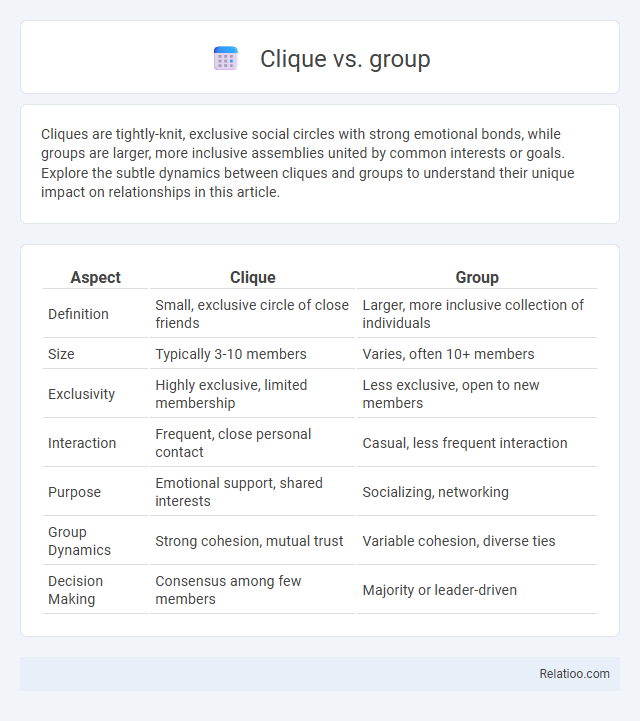Cliques are tightly-knit, exclusive social circles with strong emotional bonds, while groups are larger, more inclusive assemblies united by common interests or goals. Explore the subtle dynamics between cliques and groups to understand their unique impact on relationships in this article.
Table of Comparison
| Aspect | Clique | Group |
|---|---|---|
| Definition | Small, exclusive circle of close friends | Larger, more inclusive collection of individuals |
| Size | Typically 3-10 members | Varies, often 10+ members |
| Exclusivity | Highly exclusive, limited membership | Less exclusive, open to new members |
| Interaction | Frequent, close personal contact | Casual, less frequent interaction |
| Purpose | Emotional support, shared interests | Socializing, networking |
| Group Dynamics | Strong cohesion, mutual trust | Variable cohesion, diverse ties |
| Decision Making | Consensus among few members | Majority or leader-driven |
Definition of Clique vs Group
A clique is a small, tightly-knit circle of individuals who share close, exclusive relationships, often characterized by mutual interests or social status. A group, in contrast, consists of a broader collection of individuals assembled for a common purpose or activity, with varying levels of interaction and commitment. Understanding the distinction helps you navigate social dynamics by recognizing the intimacy and exclusivity that define a clique versus the more inclusive and goal-oriented nature of a group.
Key Characteristics of Cliques
Cliques are tightly-knit social circles characterized by exclusive membership and strong interpersonal bonds, often marked by shared interests and loyalty among members. Unlike groups, cliques maintain rigid boundaries, creating a sense of identity and belonging that can influence individual behavior and social dynamics significantly. Your understanding of cliques highlights their role in fostering close relationships while potentially limiting social diversity.
Key Characteristics of Groups
Groups exhibit key characteristics such as a clear structure, defined roles, and shared goals that distinguish them from cliques, which are smaller, more exclusive subgroups often united by personal bonds rather than purpose. Unlike cliques, groups emphasize collaboration, communication, and collective decision-making to achieve common objectives. Your understanding of these distinctions enhances effective team building and social dynamics management.
Social Dynamics and Interactions
Cliques are small, exclusive circles where members share strong bonds and often exclude outsiders, influencing social hierarchies and individual behavior within a community. Groups are larger and more inclusive, forming based on common goals or interests, facilitating collaboration and diverse interactions among members. Understanding these dynamics helps you navigate social environments by recognizing how exclusivity in cliques contrasts with the broader, more flexible connections within groups.
Inclusion and Exclusion Patterns
Cliques are tightly-knit social units characterized by exclusive inclusion, where members share strong mutual connections and often exclude outsiders to maintain cohesion. Groups have more flexible inclusion criteria, allowing diverse membership with varying degrees of interaction and less rigid boundaries compared to cliques. The inclusion and exclusion patterns in cliques intensify social homogeneity, while groups accommodate broader diversity, balancing integration and differentiation within social networks.
Psychological Impact on Members
Cliques often exert intense psychological pressure on members, fostering feelings of exclusivity and social validation that can enhance self-esteem but also induce anxiety and conformity stress. Groups provide a broader social structure allowing diverse interaction and shared goals, which generally promote inclusivity and reduce social anxiety, supporting healthier self-concepts. The psychological impact of cliques within groups can create internal conflicts, as members may struggle between the desire for clique acceptance and the benefits of group cohesion.
Role of Leadership and Influence
In social networks, cliques are tightly-knit clusters where leadership often emerges through dominant influence and mutual reinforcement, creating strong internal cohesion. Groups consist of broader members with more diverse roles, where leadership tends to be more formalized or assigned, balancing individual influence with group objectives. Cliques typically wield concentrated influence through charismatic leaders, while groups distribute leadership roles to harness collective strengths and facilitate broader participation.
Clique vs Group in Educational Settings
Cliques in educational settings are small, exclusive groups characterized by close-knit peer relationships and shared interests, often influencing social dynamics and student behavior. Groups, by contrast, are larger, more inclusive assemblies formed for academic collaboration or extracurricular activities, promoting diverse interaction and collective goals. Understanding the distinctions between cliques and groups can help you foster a more inclusive and productive classroom environment.
Effects on Social Development
Cliques often limit social development by promoting exclusivity and reinforcing conformity among members, which can hinder empathy and diverse social skills. Groups provide a broader social environment where individuals can develop teamwork, communication, and leadership abilities through shared goals and cooperation. Unlike cliques, which are tightly-knit and selective, groups facilitate inclusive interactions that support emotional growth and adaptability in social settings.
Navigating Clique and Group Membership
Navigating clique and group membership requires understanding social dynamics where cliques emphasize exclusive, tightly-knit relationships marked by strong loyalty and shared interests. Groups tend to be larger, more inclusive, and structured around common goals or activities, offering diverse connections and varying levels of commitment. Recognizing the distinction between the intense bonds of a clique and the broader alliances within a group aids in managing social integration and personal identity within these networks.

Infographic: Clique vs Group
 relatioo.com
relatioo.com